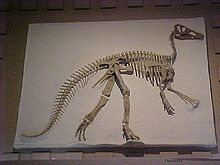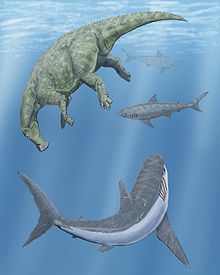- Claosaurus
-
Claosaurus
Temporal range: Late CretaceousScientific classification Kingdom: Animalia Phylum: Chordata Class: Sauropsida Superorder: Dinosauria Order: Ornithischia Suborder: Ornithopoda Infraorder: Iguanodontia Superfamily: Hadrosauroidea Family: Hadrosauridae? Genus: Claosaurus
Marsh, 1890Species - C. agilis (Marsh, 1872 [originally Hadrosaurus agilis]) (type)
- "C. affinis" Wieland, 1903 (nomen dubium)*
Claosaurus, (pronounced /ˌkleɪ.ɵˈsɔrəs/ klay-o-sawr-əs, meaning 'broken lizard', referring to the odd position of the fossils when discovered (Greek κλάο, klao meaning 'broken' and σαυρος, sauros meaning 'lizard') is a genus of primitive hadrosaurid (duck-billed dinosaur) that lived during the Late Cretaceous Period (Santonian).
Evidence of its existence was first found near the Smoky Hill River in Kansas, USA in the form of partial skull fragments and as an articulated postcranial skeleton. Originally named Hadrosaurus agilis (Marsh, 1872), it was placed in a new genus and renamed Claosaurus agilis in 1890 when major differences between this specimen and Hadrosaurus came to light.
Claosaurus had a slender body and slim feet, with long legs, small arms, and a long, stiff tail. It probably grew to a length of about 3.5 meters (12 to 16 feet) and weighed roughly 475 kg.
It appears to have walked on its hind legs, dropping to all fours only to graze. Like other hadrosaurs, it was an herbivore.
Original, as described by Marsh, 1872:
1. Notice of a new species of Hadrosaurus; by O. C. MARSH. Among the Reptilian remains obtained by the Yale College party during the past summer (1871) was the greater part of a skeleton of a small Hadrosaurus, discovered by the writer in the blue Cretaceous shale near the Smoky Hill River, in Western Kansas. This species was somewhat smaller than H. minor Marsh, from New Jersey, and hardly more than one-third the bulk of H. Foulkei of Leidy. It was of more slender proportions, with the tail much elongated. The cervical vertebra are proportionally shorter than in H. Foulkei, and the caudals appear more compressed, Some of the distal caudals have a longitudinal ridge on the lateral surface. The sacrum, which is composed of six confluent vertebræ is 414 mm. in length. The first caudal vertebra is 62 mm. in length. The feet are nearly entire, and are proportionally more slender than the known remains of the other species would indicate. The third metatarsal is 235 mm. in length, and 77 mm. in transverse diameter at its distal end. This species, which may be called Hadrosaurus agilis, will be fully described in this Journal at an early day.
Yale College, New Haven, March 19, 1872.
In 1892, Marsh named a second species, C. annectens. This species later was reassigned to Anatosaurus and then Edmontosaurus, where it is currently.[1] G. R. Wieland named third species C. affinis in 1903, which he compared to C. annectens. C. affinis was founded on remains from the Pierre Shale of South Dakota, found in association with remains of the giant sea turtle Archelon. At some point after its description, the fragmentary remains were mixed up with the original remains of C. agilis, and a toe bone from C. agilis was accidentally thought to be the only part of the holotype remains that could be located. This was corrected by Joseph Gregory in 1948, who found three toe bones from the right foot of a large hadrosaur in the Yale collections that had comparable preservation to the Pierre Shale turtle remains and were associated with labels in Wieland's handwriting. Gregory found the toe bones to be very similar in size to the corresponding bones of Marsh's Claosaurus annectens, but did not reassign the species due to its much older age and fragmentary remains.[2] "C. affinis" was considered a dubious hadrosaur in the 2004 review by Jack Horner and colleagues. They reported its type material as lost, although they also reported these remains as only including a single toe bone, instead of the three toe bones of Gregory.[1]
Reports of gastroliths, or stomach stones, in Claosaurus are actually based on a probable double misidentification. First, the specimen is actually of Edmontosaurus annectens. Barnum Brown, who discovered the specimen in 1900, referred to it as Claosaurus, because E. annectens was thought to be a species of Claosaurus at the time. Additionally, it is more likely that the supposed gastroliths represent gravel washed in during burial.[3]
Notes
^ * This species is not accepted as representing Claosaurus in reviews of the genus, but has not been given its own genus and is unlikely to receive one.
References
- ^ a b Horner, John R.; Weishampel, David B.; and Forster, Catherine A (2004). "Hadrosauridae". In Weishampel, David B.; Dodson, Peter; and Osmólska, Halszka (eds.). The Dinosauria (2nd ed.). Berkeley: University of California Press. pp. 438–463. ISBN 0-520-24209-2.
- ^ Gregory, Joseph T. (1948). "The type of Claosaurus (?) affinis Wieland". American Journal of Science 246: 29–30. doi:10.2475/ajs.246.1.29.
- ^ Creisler, Benjamin S. (2007). "Deciphering duckbills: a history in nomenclature". In Carpenter, Kenneth (ed.). Horns and Beaks: Ceratopsian and Ornithopod Dinosaurs. Bloomington and Indianapolis: Indiana University Press. pp. 185–210. ISBN 0-253-34817-X.
Categories:- Dinosaurs of North America
- Cretaceous dinosaurs
- Hadrosaurs
Wikimedia Foundation. 2010.



